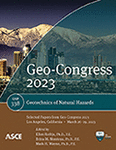A Constitutive Model to Simulate Cementation Effects in Sands
Publication: Geo-Congress 2023
ABSTRACT
Naturally cemented sands exhibit heightened mechanical properties compared to clean sands as a result of the action of crystal binders that strengthen the structure of such materials. Based on this observation, a myriad of ground improvement techniques such as bio-cementation and polymerization have been developed to artificially cement sands. Despite such techniques finding increasing applications, a handful of constitutive models remain available to capture their effects on the mechanics of sands. To advance the state of the art, this article describes a constitutive model for capturing the mechanics of cemented sands: SANISAND-C*. This work specifically focuses on a succinct overview of the mathematical formulation of such model and its application to the simulation of drained and undrained triaxial compression tests of cemented and clean sands. Results indicate that the model can realistically reproduce multiple effects caused by the natural or artificial cementation of sands, such as their increased strength and stiffness, changes in dilatancy, and the destructuration of cementation bonds upon mechanical loading. Accordingly, the model represents a powerful tool for computational analyses involving cemented sands for both scientific and engineering purposes.
Get full access to this article
View all available purchase options and get full access to this chapter.
REFERENCES
Cheng, L., R. Cord-Ruwisch, and M. A. Shahin. 2013. “Cementation of sand soil by microbially induced calcite precipitation at various degrees of saturation.” Can. Geotech. J., 50 (1): 81–90. NRC Research Press.
Cheng, L., M. A. Shahin, and R. Cord-Ruwisch. 2014. “Bio-cementation of sandy soil using microbially induced carbonate precipitation for marine environments.” Géotechnique, 64 (12): 1010–1013. https://doi.org/10.1680/geot.14.T.025.
Choi, S.-G., S. Wu, and J. Chu. 2016. “Biocementation for Sand Using an Eggshell as Calcium Source.” J. Geotech. Geoenvironmental Eng., 142 (10): 06016010. American Society of Civil Engineers. https://doi.org/10.1061/(ASCE)GT.1943-5606.0001534.
Cui, M.-J., J.-J. Zheng, R.-J. Zhang, H.-J. Lai, and J. Zhang. 2017. “Influence of cementation level on the strength behaviour of bio-cemented sand.” Acta Geotech., 12 (5): 971–986. Springer.
Dafalias, Y. F., and M. T. Manzari. 2004. “Simple plasticity sand model accounting for fabric change effects.” J. Eng. Mech., 130 (6): 622–634. American Society of Civil Engineers.
Gai, X., and M. Sánchez. 2019. “An elastoplastic mechanical constitutive model for microbially mediated cemented soils.” Acta Geotech., 14 (3): 709–726. https://doi.org/10.1007/s11440-018-0721-y.
Kortbawi, M. E., K. Ziotopoulou, M. G. Gomez, and M. Lee. 2019. Validation of a Bounding Surface Plasticity Model against the Experimental Response of (Bio-) Cemented Sands. 197–207. American Society of Civil Engineers. https://doi.org/10.1061/9780784482100.021.
Landivar Macias, A., and A. F. Rotta Loria. 2022. “SANISAND-C*: Simple ANIsotropic constitutive model for SAND with Cementation.” Int. J. Numer. Anal. Methods Geomech., Under review.
Mitchell, J. K. 1970. “In-Place Treatment of Foundation Soils.” J. Soil Mech. Found. Div., 96 (1): 73–110.
Mitchell, J. K., and K. Soga. 2005. Fundamentals of soil behavior. New York: Wiley.
Molenaar, N., and A. A. M. Venmans. 1993. “Calcium carbonate cementation of sand: A method for producing artificially cemented samples for geotechnical testing and a comparison with natural cementation processes.” Eng. Geol., 35 (1–2): 103–122. https://doi.org/10.1016/0013-7952(93)90073-L.
Montoya, B. M., and J. T. DeJong. 2015. “Stress-strain behavior of sands cemented by microbially induced calcite precipitation.” J. Geotech. Geoenvironmental Eng., 141 (6): 04015019. American Society of Civil Engineers.
Mujah, D., M. A. Shahin, and L. Cheng. 2017. “State-of-the-art review of biocementation by microbially induced calcite precipitation (MICP) for soil stabilization.” Geomicrobiol. J., 34 (6): 524–537. Taylor & Francis.
Nafisi, A., D. Mocelin, B. M. Montoya, and S. Underwood. 2020. “Tensile strength of sands treated with microbially induced carbonate precipitation.” Can. Geotech. J., 57 (10): 1611–1616. NRC Research Press. https://doi.org/10.1139/cgj-2019-0230.
van Paassen, L. A., R. Ghose, T. J. van der Linden, W. R. van der Star, and M. C. van Loosdrecht. 2010. “Quantifying biomediated ground improvement by ureolysis: large-scale biogrout experiment.” J. Geotech. Geoenvironmental Eng., 136 (12): 1721–1728. American Society of Civil Engineers.
Plank, J. 2004. “Applications of biopolymers and other biotechnological products in building materials.” Appl. Microbiol. Biotechnol., 66 (1): 1–9. https://doi.org/10.1007/s00253-004-1714-3.
Qabany, A. A., and K. Soga. 2013. “Effect of chemical treatment used in MICP on engineering properties of cemented soils.” Géotechnique, 63 (4): 331–339. ICE Publishing. https://doi.org/10.1680/geot.SIP13.P.022.
Rahimi, M., D. Chan, and A. Nouri. 2016. “Bounding Surface Constitutive Model for Cemented Sand under Monotonic Loading.” Int. J. Geomech., 16 (2): 04015049. American Society of Civil Engineers. https://doi.org/10.1061/(ASCE)GM.1943-5622.0000534.
Sariosseiri, F., and B. Muhunthan. 2009. “Effect of cement treatment on geotechnical properties of some Washington State soils.” Eng. Geol., 104 (1): 119–125. https://doi.org/10.1016/j.enggeo.2008.09.003.
Soon, N. W., L. M. Lee, T. C. Khun, and H. S. Ling. 2014. “Factors Affecting Improvement in Engineering Properties of Residual Soil through Microbial-Induced Calcite Precipitation.” J. Geotech. Geoenvironmental Eng., 140 (5): 04014006. American Society of Civil Engineers. https://doi.org/10.1061/(ASCE)GT.1943-5606.0001089.
Taiebat, M., and Y. F. Dafalias. 2008. “SANISAND: Simple anisotropic sand plasticity model.” Int. J. Numer. Anal. Methods Geomech., 32 (8): 915–948. https://doi.org/10.1002/nag.651.
Terzis, D., and L. Laloui. 2018. “3-D micro-architecture and mechanical response of soil cemented via microbial-induced calcite precipitation.” Sci. Rep., 8 (1): 1–11. https://doi.org/10.1038/s41598-018-19895-w.
Wang, Y. H., and S. C. Leung. 2008. “Characterization of cemented sand by experimental and numerical investigations.” J. Geotech. Geoenvironmental Eng., 134 (7): 992–1004. American Society of Civil Engineers.
Zaimoglu, A. S. 2011. “Engineering properties of sand stabilised with borogypsum.” Proc. Inst. Civ. Eng.-Geotech. Eng., 164 (4): 277–282. Thomas Telford Ltd.
Zhang, A., Y. F. Dafalias, and M. Jiang. 2021. “A bounding surface plasticity model for cemented sand under monotonic and cyclic loading.” Géotechnique, 1–18. Thomas Telford Ltd.
Zhao, Y., C. Fan, P. Liu, H. Fang, and Z. Huang. 2018. “Effect of activated carbon on microbial-induced calcium carbonate precipitation of sand.” Environ. Earth Sci., 77 (17): 615. https://doi.org/10.1007/s12665-018-7797-4.
Information & Authors
Information
Published In
History
Published online: Mar 23, 2023
ASCE Technical Topics:
Authors
Metrics & Citations
Metrics
Citations
Download citation
If you have the appropriate software installed, you can download article citation data to the citation manager of your choice. Simply select your manager software from the list below and click Download.
